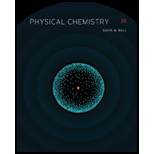
PHYSICAL CHEMISTRY-STUDENT SOLN.MAN.
2nd Edition
ISBN: 9781285074788
Author: Ball
Publisher: CENGAGE L
expand_more
expand_more
format_list_bulleted
Question
Chapter 14, Problem 14.58E
Interpretation Introduction
Interpretation:
Arrows, indicating the vibrational modes of
Concept introduction:
Vibrational spectroscopy is observed due to vibrational motion accompanied in a molecule. The mode which is IR active is associated with the change in the dipole moment of the molecule.
Expert Solution & Answer
Want to see the full answer?
Check out a sample textbook solution
Students have asked these similar questions
Can I get some help drawing my arrows. I included what the final needs to look like
please help
(a)
(e)
O₂N.
(h)
21.8 Name the following compounds.
Br
(f)
Ph.
(c)
(d)
Br
(g)
NO₂
H
NH2
Br
mo. 0-0.
OMe
(i)
Chapter 14 Solutions
PHYSICAL CHEMISTRY-STUDENT SOLN.MAN.
Ch. 14 - Prob. 14.1ECh. 14 - Determine if the following integrals can be...Ch. 14 - What is the frequency of light having the...Ch. 14 - What is the wavelength of light having the given...Ch. 14 - What is the energy of light having each...Ch. 14 - The Cu(H2O)62+ complex has octahedral symmetry. Is...Ch. 14 - What are the wavelength, speed, and energy of a...Ch. 14 - Prob. 14.8ECh. 14 - Prob. 14.9ECh. 14 - Prob. 14.10E
Ch. 14 - Prob. 14.11ECh. 14 - Prob. 14.12ECh. 14 - Prob. 14.13ECh. 14 - Prob. 14.14ECh. 14 - Diatomic sulfur, S2, was detected in the tail of...Ch. 14 - Prob. 14.16ECh. 14 - Prob. 14.17ECh. 14 - Prob. 14.18ECh. 14 - Prob. 14.19ECh. 14 - Prob. 14.20ECh. 14 - Prob. 14.21ECh. 14 - Prob. 14.22ECh. 14 - Which of the following molecules should have pure...Ch. 14 - Which of the following molecules should have pure...Ch. 14 - The following are sets of rotational quantum...Ch. 14 - The following are sets of rotational quantum...Ch. 14 - Derive equation 14.21 from the E expression...Ch. 14 - Prob. 14.28ECh. 14 - Prob. 14.29ECh. 14 - Lithium hydride, 7Li1H, is a potential fuel for...Ch. 14 - Prob. 14.31ECh. 14 - Prob. 14.32ECh. 14 - Prob. 14.33ECh. 14 - Prob. 14.34ECh. 14 - Prob. 14.35ECh. 14 - Prob. 14.36ECh. 14 - From the data in Table 14.2, predict B for DCl D...Ch. 14 - A colleague states that the pure rotational...Ch. 14 - Prob. 14.39ECh. 14 - Prob. 14.40ECh. 14 - Prob. 14.41ECh. 14 - Prob. 14.42ECh. 14 - Prob. 14.43ECh. 14 - Determine E for J=20J=21 for HBr assuming it acts...Ch. 14 - Determine the number of total degrees of freedom...Ch. 14 - Determine the number of total degrees of freedom...Ch. 14 - Prob. 14.47ECh. 14 - Prob. 14.48ECh. 14 - Prob. 14.49ECh. 14 - Prob. 14.50ECh. 14 - Prob. 14.51ECh. 14 - Prob. 14.52ECh. 14 - Prob. 14.53ECh. 14 - Prob. 14.54ECh. 14 - Prob. 14.55ECh. 14 - Prob. 14.56ECh. 14 - Prob. 14.57ECh. 14 - Prob. 14.58ECh. 14 - Prob. 14.59ECh. 14 - Prob. 14.60ECh. 14 - Prob. 14.61ECh. 14 - Prob. 14.62ECh. 14 - Prob. 14.63ECh. 14 - Prob. 14.64ECh. 14 - Prob. 14.65ECh. 14 - Prob. 14.66ECh. 14 - Prob. 14.68ECh. 14 - Prob. 14.69ECh. 14 - Prob. 14.70ECh. 14 - Prob. 14.71ECh. 14 - Prob. 14.72ECh. 14 - Prob. 14.73ECh. 14 - Prob. 14.74ECh. 14 - Prob. 14.75ECh. 14 - Prob. 14.76ECh. 14 - Prob. 14.77ECh. 14 - Prob. 14.78ECh. 14 - Prob. 14.79ECh. 14 - Prob. 14.80ECh. 14 - Prob. 14.81ECh. 14 - Prob. 14.82ECh. 14 - Prob. 14.83ECh. 14 - Prob. 14.84ECh. 14 - Prob. 14.85ECh. 14 - Dioctyl sulfide, (C8H17)2S, and hexadecane,...Ch. 14 - Where would you expect vibrations for ethyl...Ch. 14 - Prob. 14.88ECh. 14 - Prob. 14.89ECh. 14 - Prob. 14.90ECh. 14 - Prob. 14.91ECh. 14 - Prob. 14.92ECh. 14 - Prob. 14.93ECh. 14 - Prob. 14.94ECh. 14 - The mutual exclusion rule states that for certain...Ch. 14 - Prob. 14.96ECh. 14 - Prob. 14.97ECh. 14 - Prob. 14.98ECh. 14 - Prob. 14.99ECh. 14 - Construct and compare the energy level diagrams...Ch. 14 - Prob. 14.101E
Knowledge Booster
Similar questions
- Can I get helpp drawing my arrowsarrow_forwardWhich of the m/z values corresponds to the base peak in the mass spectrum shown? 100 80 A. 45 B. 44 C. 29 D. 15 Intensity 20 0 10 20 30 40 B- m/z -8 50 E. 30 Which of the m/z values correspond to the molecular ion for the compound shown? A. 18 B. 82 OH C. 100 D. 102 E. 103arrow_forwardCan someone help me with drawing my arrows.arrow_forward
- I'm having trouble with converting lewis diagrams into VSEPR diagrams. I currently have this example of C2BrCl3 which I want to turn into a lewis structure, but I'm not sure what steps I need to do in order to do so. I have the table written down, however, there's two central atoms so what would I do? There seems to be 4 electron domains on the carbon atom and no lone pairs so it would seem like this shape would be tetrahedral. Here's what I have now. Thanks!arrow_forwardWe discussed the solid phase resin using in peptide synthesis. Provide a mechanism, for its formation. DRAW THE MECHANISM.arrow_forwardPlease help. Every time I've asked an expert in the past, it's been wrong :(arrow_forward
arrow_back_ios
SEE MORE QUESTIONS
arrow_forward_ios
Recommended textbooks for you
 Principles of Modern ChemistryChemistryISBN:9781305079113Author:David W. Oxtoby, H. Pat Gillis, Laurie J. ButlerPublisher:Cengage Learning
Principles of Modern ChemistryChemistryISBN:9781305079113Author:David W. Oxtoby, H. Pat Gillis, Laurie J. ButlerPublisher:Cengage Learning Physical ChemistryChemistryISBN:9781133958437Author:Ball, David W. (david Warren), BAER, TomasPublisher:Wadsworth Cengage Learning,
Physical ChemistryChemistryISBN:9781133958437Author:Ball, David W. (david Warren), BAER, TomasPublisher:Wadsworth Cengage Learning,

Principles of Modern Chemistry
Chemistry
ISBN:9781305079113
Author:David W. Oxtoby, H. Pat Gillis, Laurie J. Butler
Publisher:Cengage Learning

Physical Chemistry
Chemistry
ISBN:9781133958437
Author:Ball, David W. (david Warren), BAER, Tomas
Publisher:Wadsworth Cengage Learning,